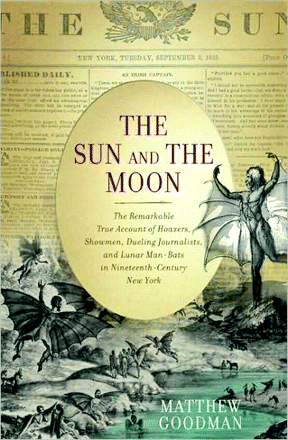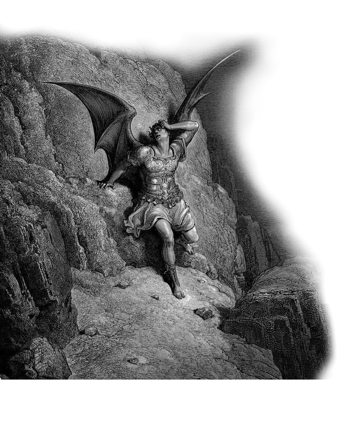“Holy hoaxes, Batman!”
- Dan Collinge, BA, Senior Editorial Coordinator of Molecular Pharmacology and is currently working on a Master’s degree in English

The Sun and the Moon: The Remarkable True Account of Hoaxers, Showmen, Dueling Journalists, and Lunar Man-Bats in Nineteenth Century New York Matthew Goodman New York: Perseus Books. 2008, 350 pages. $26.00, ISBN-13: 978-0465002573
Most Americans who were around to witness it can probably tell you where they were and what they were doing when the news broke that we had landed on the moon the moment that Neil Armstrong took his small but gigantic steps. Certainly, too, we must agree, that no less significant was the second moon landing during which Charles Conrad and Alan Bean made mankind’s first contact with the Lunarians. And who could forget when Alan Shepard swam the great inland sea, tamed a moon unicorn, and rode it past the horned bears to the Ruby Colosseum to make peace with the bipedal beavers and the talking man-bats?
What’s that? You’ve forgotten? Okay. And I suppose that you know better than to believe there are unicorns and man-bats dwelling on the moon? Fair enough. But this skeptical opinion would have put you amongst the minority of the fine citizens of New York City in the late summer of 1835. At that time, the moon teemed with flora and fauna of exotic shapes and colors, and everybody knew it to be true it was in the newspapers.
Let me explain. On August 21, 1835, The Sun, a recently established penny paper, began running a series of stories cataloging the supposed discoveries that (the very real) Sir John Herschel made with his newly invented (and completely bogus) “hydro-oxygen telescope” at the Cape of Good Hope. Surveying the moon with the never-before-dreamed-of power of the new telescope, Herschel was able to view lush forests, seas filled with aquamarine water, fields of brilliant red poppies, and the aforementioned beasts and batmen, or “Vespertilio-homo” to get a little more Linnaean. Glowing accounts of Herschel’s stupendous findings were transmitted by the fictional Dr. Andrew Grant to the fictional Supplement to the Edinburgh Journal of Science (defunct by 1835), which then “by chance” fell into the hands of Richard Adams Locke, the editor of The Sun, and, obviously, the author of the “moon hoax,” as it came to be known. That’s the hasty version. For a detailed recounting of the hoax, for a dip into the dusty and chaotic streets of nineteenth century New York, for an expertly researched chronicle of the rise of the modern newspaper, and for vividly realized depictions of an assortment of larger-than-life printers, journalists, and hucksters, turn to historian Matthew Goodman. His The Sun and The Moon is all of the above; but moreover, it is a fascinating look at one episode of friction between religion and science, and one that predated Darwin by more than two decades.
Goodman’s book is divided into halves, called: “The Sun” and (you guessed it!) “The Moon.” The Sun section details the establishment of the long-since vanished newspaper that bore this name. The paper was the brainchild of a printer named Benjamin Day, who saw an opening for a new kind of news medium. At the time, most of New York’s papers sold for six cents, a price tag that put them out of reach of the city’s growing working class, which was fine because these papers weren’t after that audience. Day’s brilliant insight was this: by offering a paper for merely one penny printing accounts of fires, crimes, and the occasional tall tale he brought a different kind of news to a new and different audience. Other entrepreneurs would follow suit, and soon, the city was awash with penny papers. But it was the moon hoax that set The Sun apart. After Locke’s tale, The Sun’s circulation increased to more than 19,000 per day more than all the six-cent papers combined and more even than the grand old Times of London making it the most widely read paper in the world. Locke and Day forged the template that would create the modern newspaper.
Many of the early chapters serve as brief biographies for the players involved in the moon hoax Locke and Day, of course, but others, too, including the young, ambitious author Edgar Allan Poe, who felt that Locke had borrowed a little too much from an earlier story of his in the moon series. Interestingly, it was rival editor James Gordon Bennett who credited Locke with the establishment of a “New Species of Literature,” which he called the “scientific novel.” However, in an ironic twist that Poe would have seen as poetic justice, Locke is all but forgotten, and Poe is now viewed as a founder of the genre of science fiction. The biographies are intriguing, but they are essentially foundation building for the good stuff. Goodman concludes his opening half with the following: “The twin conquerors of the period science and exploration had revealed to New Yorkers the very strangeness of the world, where the exotic merged with the commonplace, and nearly anything, it seemed, was possible.”
The moon series in the newspaper ran for about a week, each entry revealing more wondrous sights and creatures: at first fields of poppies, forests, seas, and outcroppings of green “‘wild castellated rocks.’” Soon, however, Herschel’s observations “‘blest our panting hopes with specimens of conscious existence’” bison-like animals with “a ‘fleshy appendage’ over their eyes ... a ‘providential contrivance’ to protect the eyes from the moon’s extremes of light and darkness.” But Herschel and Grant would do better yet in discovering bipedal beavers living in huts, having “like primitive man ... discovered the secret of fire,” and, of course, the four-foot tall man-bats, who “if it were not for their wings ... ‘would look just as well on a parade ground as some of the old cockney militia!’” Ridiculous, right? And yet, even in the jealous Poe’s estimation, nine out of ten New Yorkers bought every word of it. Still, despite the success of the series, Richard Adams Locke gazed upon the eager crowds gathered outside The Sun’s offices “with ‘a look of mingled astonishment and contempt.’” Why contempt? Because, as Goodman later explains, Locke had not meant for the story to be believed it “had not been intended as a hoax at all; it had been intended as satire.”
Locke’s personal story is not a particularly happy one. He died in relative obscurity and without much wealth thanks to a series of poor decisions and the wear of alcoholism. Some time before his death, he published a justification for the moon story, which he claimed was designed to lampoon the “‘imaginative school of philosophy,’” and to castigate the “‘theological and devotional encroachments upon the legitimate province of science.’” It was a reaction to the Second Great Awakening, a revival of evangelical Christianity that led Alexis de Tocqueville to declare that “‘Christianity reigns without obstacles, by universal consent’” in America.

Today it may seem bizarre to associate a religious revival with belief in life in outer space, but, oddly enough, that very possibility was a widely held view during that age. Goodman labels it “the plurality of worlds doctrine, or simply pluralism.” Locke’s main target was Thomas Dick, whose popular book The Christian Philosopher had argued for extraterrestrial life as further evidence of God’s great power and plan. Goodman summarizes Dick’s philosophy as follows: “God would not create beautiful worlds without also placing there beings intelligent enough to appreciate them.” Incidentally, Dick believed the lunar inhabitants (the existence of which he never doubted) to be free of original sin and living in Edenic bliss. But beliefs like Dick’s were not limited to religious thinkers; many astronomers of the age admitted to the likelihood of lunar life, John Herschel among them. Still other scientists proposed the construction of vast images and burning figures to contact the Lunarians. Centuries after Galileo, astronomy was now being used as a means to expose and praise the glory of God. Plus, it didn’t bring with it the pesky problems of geology, whose devotees were beginning to amass pretty good evidence that the world was more than 6,000 years old. This is why, after Herschel was made aware of the hoax created in his name, he was able to remark about hearing “how an American clergyman had informed his congregation that, given the late wonderful discoveries, he expected that one day he would be calling on their generosity to help purchase Bibles for the unenlightened inhabitants of the moon.” The irony of it all is that what became known as a hoax after the religious and scientific fervor subsided was really a plea for the separation of religion and science.
Goodman’s account of this tension is riveting, and I have, therefore, to make a minor complaint that it takes so long for him to get to this discussion. My other critiques are equally small. One of the book’s greatest strengths is the absorbing tangential commentary, but this can occasionally lend it a slightly disjointed flow. Also, the narrative evolves biographically rather than chronologically, and I could have used a timeline either at the front of the book or in an appendix to keep the sequence of events straight. Another appendix could perhaps have included a full reprint of the original moon story, of which we are given only snippets. Finally, it might have been interesting to know to what, if any, extent moves like those made by Locke and Day influenced the modern tabloid press. The moon story, to us, is most reminiscent of something we might see on the cover of The Weekly World News in line at the grocery store.
The Sun and the Moon is terrific. Its depth, its humor, and the rendering of its characters are impeccable. Not only that, I believe it is a vital educational tool: we must familiarize ourselves with our closest neighbors, so that we will all be ready when the man-bats attack.
- © American Society for Pharmacology and Experimental Theraputics 2009



